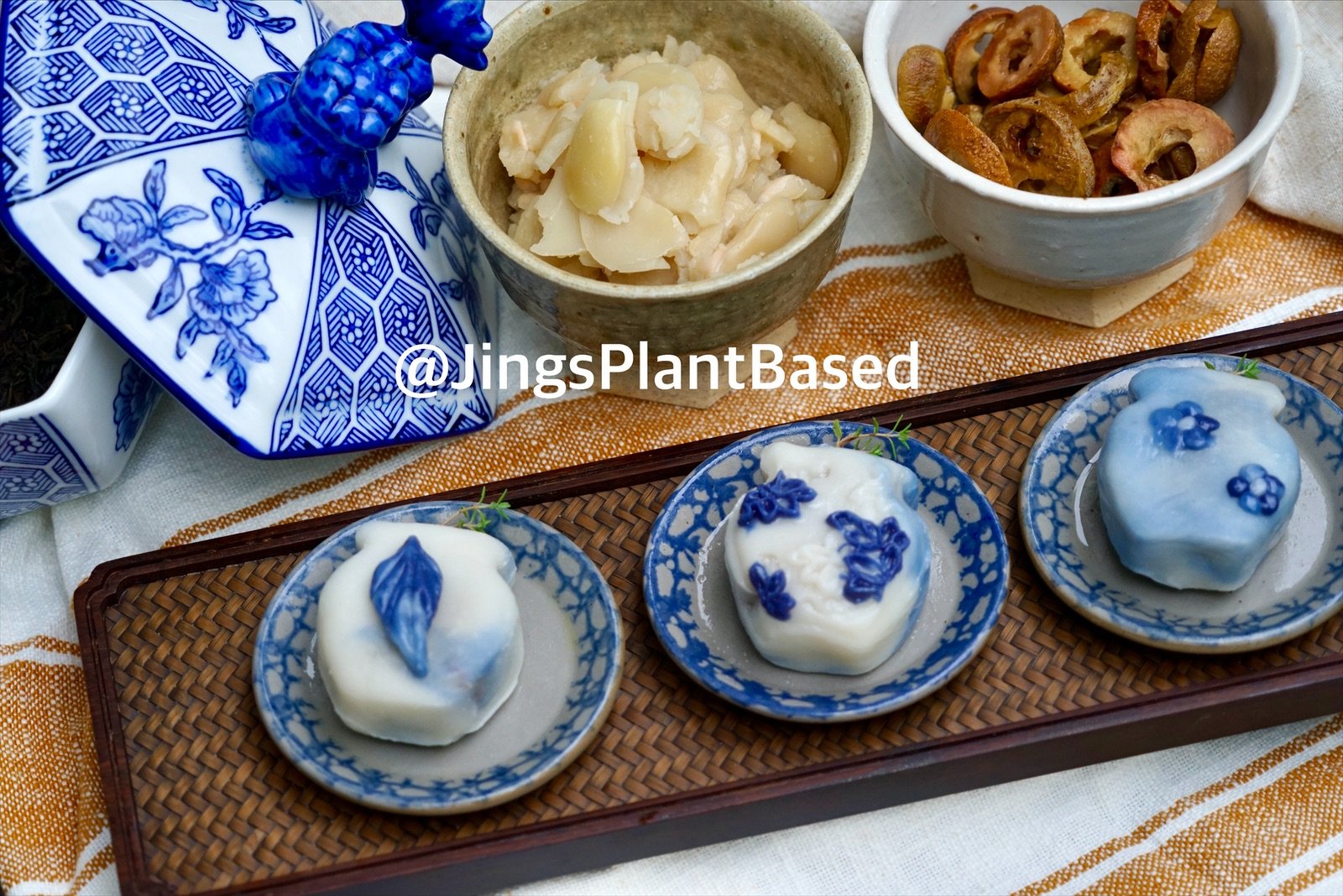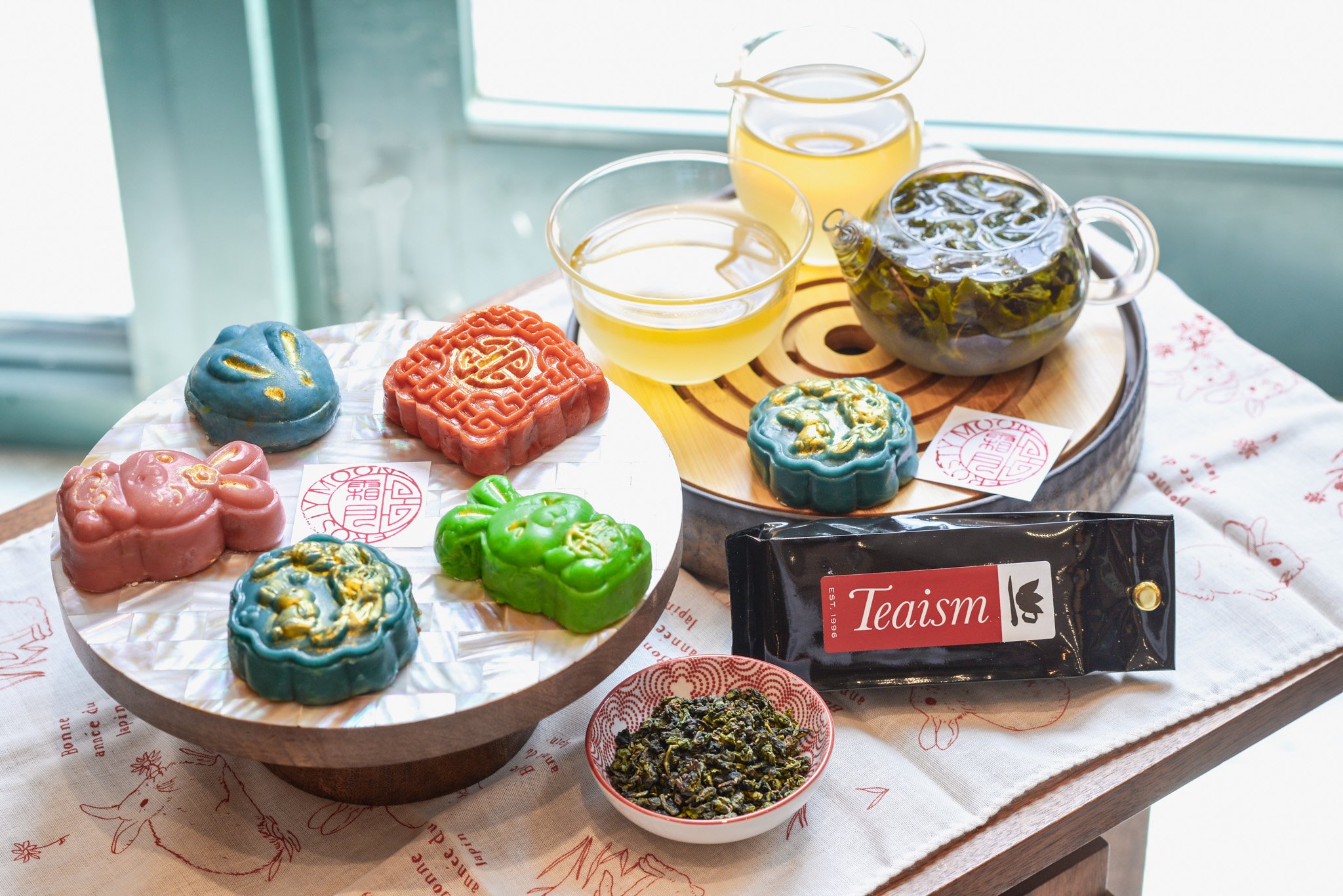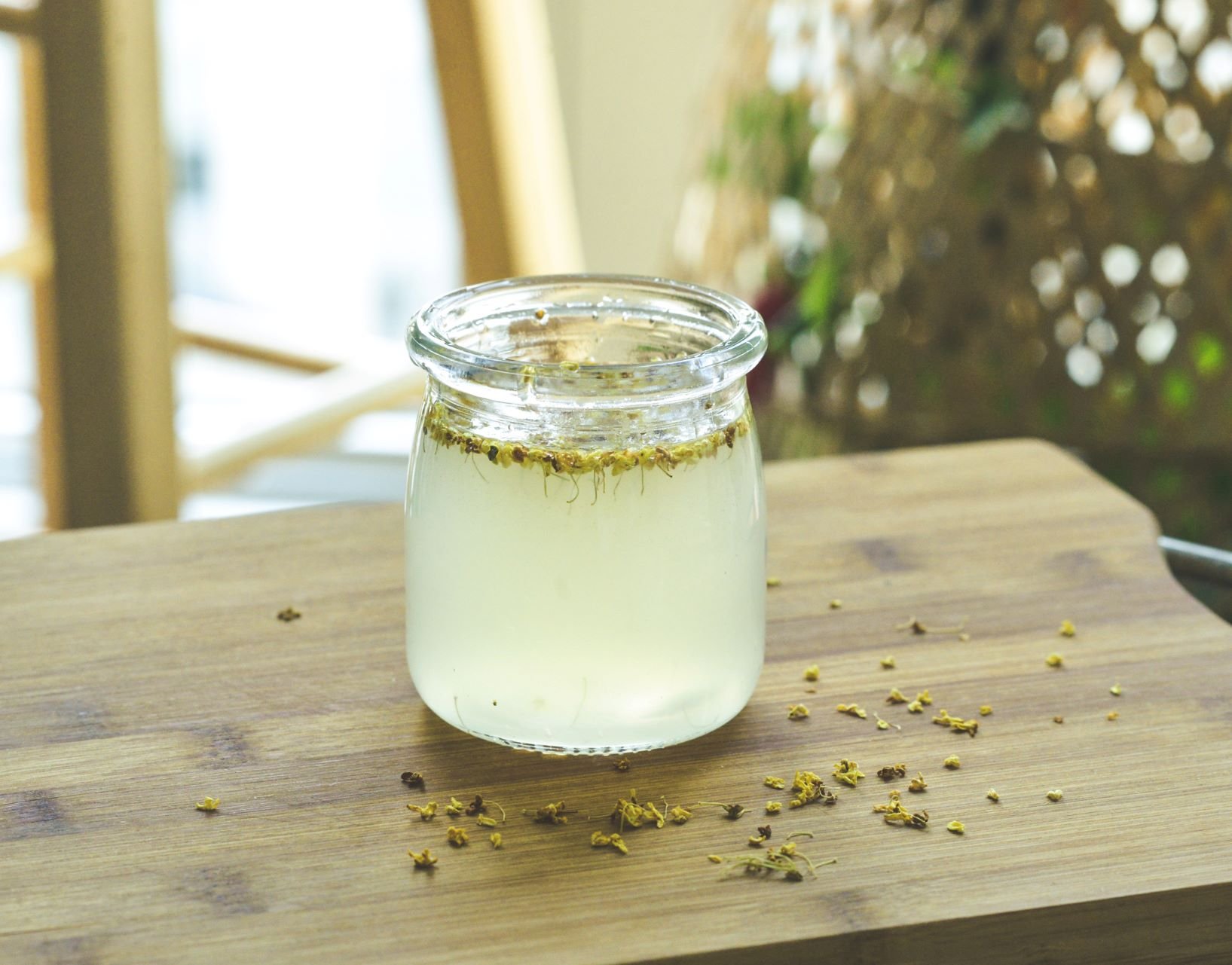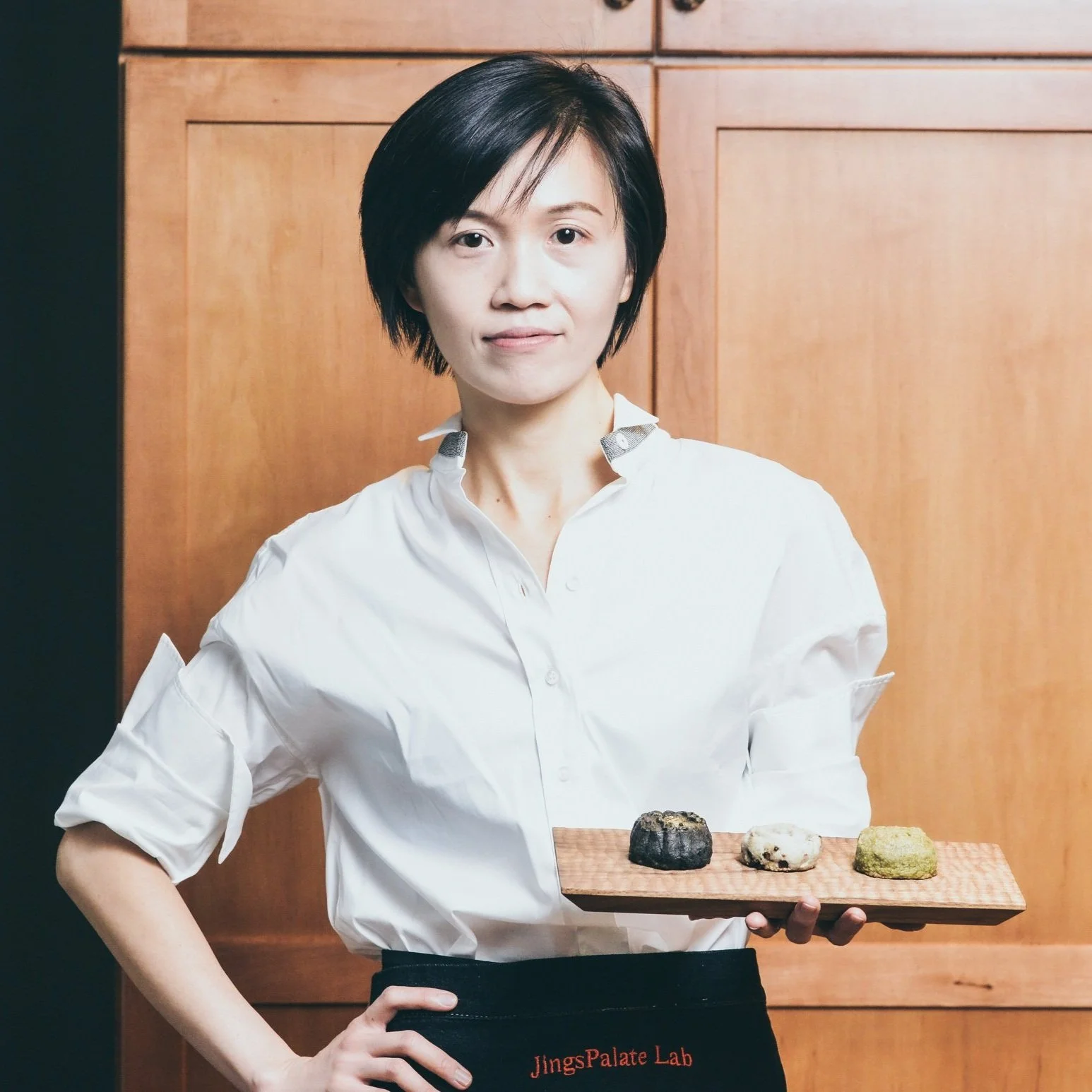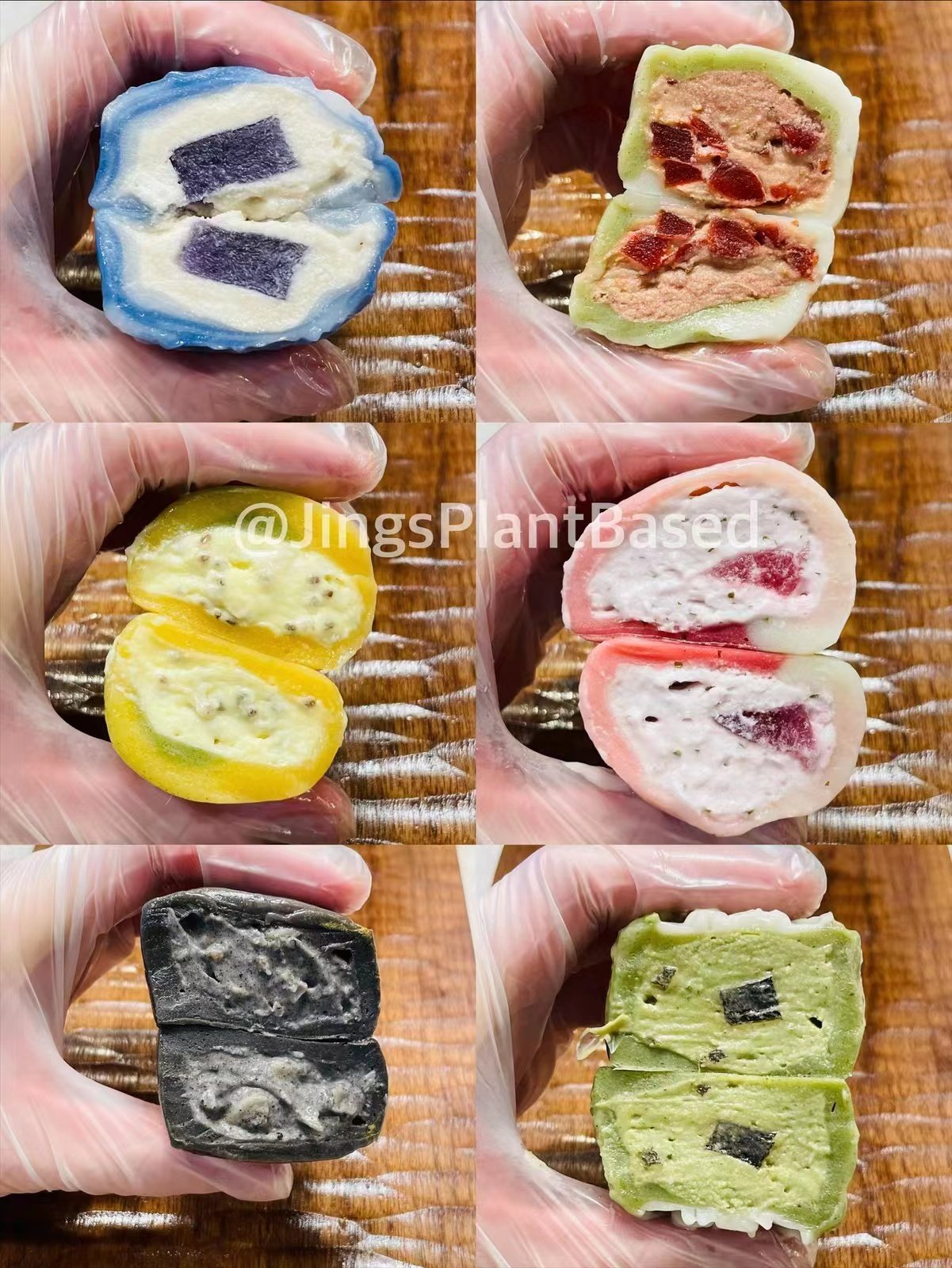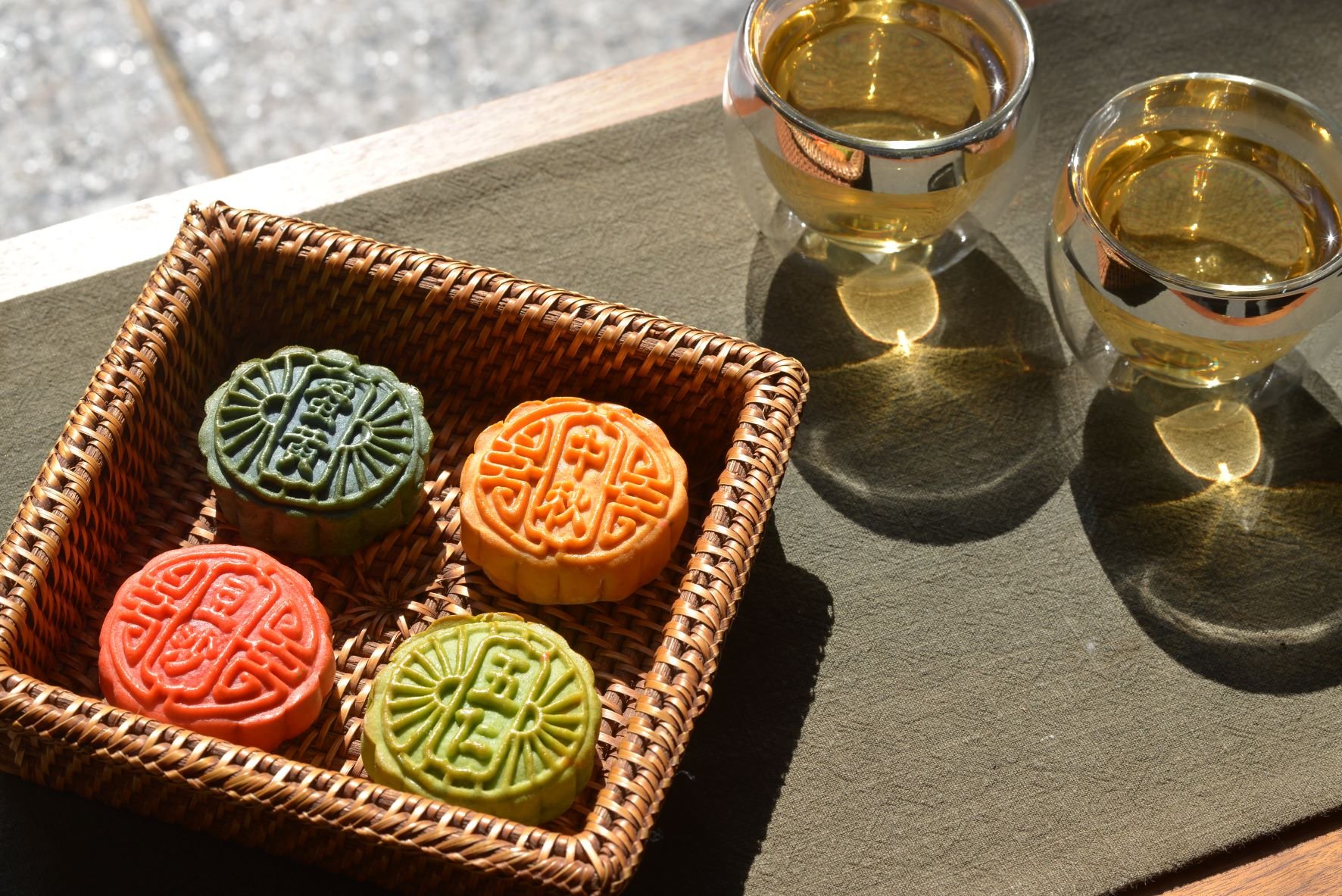2023 Mid-Autumn Festival Collection
These gift sets are being offered on a promotional basis to showcase the special mooncake dessert for the Mid-Autumn Festival. Pickups and deliveries for these products will be limited to the period beginning Sept. 22nd (first come first serve). You can find more details by visiting our shop online.
Package:
Pre-packed
——————————————————————————————————
The mooncake selections Guest Chef Jing prepared this year are inspired by her trip back to China in the summer.
The Four Historical Capitals Collection (GFV ) (4 pieces)
Xi’an ( 西安 ), ink wash painting: Osmanthus infused sweet jiuniang (酒酿, similar to fermented rice pudding) and cheese. The round shape imitates the dessert ruanlao (“soft curd”, curd filled rice dough) from Song Dynasty.
Luoyang (洛阳), turquoise: Luoyang is known as “the city of Peonies". According to traditions, the peony is demoted to Luoyang for the peony spirit refused to cater Empress Wu Zetian (r. 665–690 AD, Tang Dynasty), who demanded all flowers to blossom in winter for her pleasure. The filling is peony petal jam. The dragon shape celebrates the turquoise-inlaid dragon which was discovered in the archeological excavation site of the imperial palace of Xia Dynasty (c. 2070 – c. 1600 BC) in Erlitou (二里头), near Luoyang.
Beijing (北京), blue and white porcelain: though Beijing had been the State of Yan’s capital in the early first millennium BC, it is best known for its metropolitan atmosphere during the Yuan Dynasty when blue and white porcelain was invented and exported. The filling is Chinese hawberry, which is the main ingredient for Beijingers’ iconic snack, bingtanghulu (ice sugar-coated Chinese hawberries, 冰糖葫蘆).
Nanjing (南京), yuhua stone, yuhua tea: yuhua (雨花), in Chinese literally means rain and flowers, is a compliment for things related to Nanjing and has auspicious meaning. Yuhua stones are colourful pebbles, and Yuhua tea is a kind of green tea that brings soft, sweet earthy flavour and delicate aroma. Ruyi (lit. “as you wish,” a curved decorative object in China) shape.
*About snow skin mooncakes: this type of non-baked mooncake originates from Hong Kong in the 1960s and has become popular across China and other Southeast Asian countries. It is always served cold, perfect for early Mid-Autumn Festivals (such as this year) when heat is still lingering. The skin, mainly made of sticky rice flour and rice flour, has a slightly chewy and elastic texture. Ice cream is the most common filling. Jing also adds crunchy elements or jelly layers to enhance the contrasts.
—————————————————————————————————————
Traditional Cantonese-Styled Mooncake Collection by Chinese Street Market
Traditional Wheat Dough Mooncake Filled with Classic Flavors and more
To kick off the Mid-Autumn session, we are bringing some of the classic Cantonese-style mooncake fillings with our own interpretation.
Lotus Seed Paste & Salted Egg Yolk (蓮蓉蛋黃)
Handcrafted Taro Paste (奶香芋蓉)
Red Bean Paste & Tangerine Zest (橙皮紅豆沙)
Classic Chinese Candy - The Big White Rabbit Candy Flavor (大白兔奶糖)
——————————————————————————————————————
Tea Pairing: Osmanthus Oolong by Teaism DC
Tea is the loyalist companion to mooncakes and most Chinese desserts. Depending on the flavor of the mooncakes, Chinese choose different teas, as people do dessert and wine pairing in western cuisines. The Osmanthus Oolong by Teaism can go with all our mooncakes, especially the traditional Cantonese-styled mooncakes. This batch of oolong tea leaves were dried in a room filled with dry osmanthus flowers. The tea absorbed the aroma into the leaves. You can smell the fragment from the osmanthus flowers while drinking the tea.
These gift sets are being offered on a promotional basis to showcase the special mooncake dessert for the Mid-Autumn Festival. Pickups and deliveries for these products will be limited to the period beginning Sept. 22nd (first come first serve). You can find more details by visiting our shop online.
Package:
Pre-packed
——————————————————————————————————
The mooncake selections Guest Chef Jing prepared this year are inspired by her trip back to China in the summer.
The Four Historical Capitals Collection (GFV ) (4 pieces)
Xi’an ( 西安 ), ink wash painting: Osmanthus infused sweet jiuniang (酒酿, similar to fermented rice pudding) and cheese. The round shape imitates the dessert ruanlao (“soft curd”, curd filled rice dough) from Song Dynasty.
Luoyang (洛阳), turquoise: Luoyang is known as “the city of Peonies". According to traditions, the peony is demoted to Luoyang for the peony spirit refused to cater Empress Wu Zetian (r. 665–690 AD, Tang Dynasty), who demanded all flowers to blossom in winter for her pleasure. The filling is peony petal jam. The dragon shape celebrates the turquoise-inlaid dragon which was discovered in the archeological excavation site of the imperial palace of Xia Dynasty (c. 2070 – c. 1600 BC) in Erlitou (二里头), near Luoyang.
Beijing (北京), blue and white porcelain: though Beijing had been the State of Yan’s capital in the early first millennium BC, it is best known for its metropolitan atmosphere during the Yuan Dynasty when blue and white porcelain was invented and exported. The filling is Chinese hawberry, which is the main ingredient for Beijingers’ iconic snack, bingtanghulu (ice sugar-coated Chinese hawberries, 冰糖葫蘆).
Nanjing (南京), yuhua stone, yuhua tea: yuhua (雨花), in Chinese literally means rain and flowers, is a compliment for things related to Nanjing and has auspicious meaning. Yuhua stones are colourful pebbles, and Yuhua tea is a kind of green tea that brings soft, sweet earthy flavour and delicate aroma. Ruyi (lit. “as you wish,” a curved decorative object in China) shape.
*About snow skin mooncakes: this type of non-baked mooncake originates from Hong Kong in the 1960s and has become popular across China and other Southeast Asian countries. It is always served cold, perfect for early Mid-Autumn Festivals (such as this year) when heat is still lingering. The skin, mainly made of sticky rice flour and rice flour, has a slightly chewy and elastic texture. Ice cream is the most common filling. Jing also adds crunchy elements or jelly layers to enhance the contrasts.
—————————————————————————————————————
Traditional Cantonese-Styled Mooncake Collection by Chinese Street Market
Traditional Wheat Dough Mooncake Filled with Classic Flavors and more
To kick off the Mid-Autumn session, we are bringing some of the classic Cantonese-style mooncake fillings with our own interpretation.
Lotus Seed Paste & Salted Egg Yolk (蓮蓉蛋黃)
Handcrafted Taro Paste (奶香芋蓉)
Red Bean Paste & Tangerine Zest (橙皮紅豆沙)
Classic Chinese Candy - The Big White Rabbit Candy Flavor (大白兔奶糖)
——————————————————————————————————————
Tea Pairing: Osmanthus Oolong by Teaism DC
Tea is the loyalist companion to mooncakes and most Chinese desserts. Depending on the flavor of the mooncakes, Chinese choose different teas, as people do dessert and wine pairing in western cuisines. The Osmanthus Oolong by Teaism can go with all our mooncakes, especially the traditional Cantonese-styled mooncakes. This batch of oolong tea leaves were dried in a room filled with dry osmanthus flowers. The tea absorbed the aroma into the leaves. You can smell the fragment from the osmanthus flowers while drinking the tea.
These gift sets are being offered on a promotional basis to showcase the special mooncake dessert for the Mid-Autumn Festival. Pickups and deliveries for these products will be limited to the period beginning Sept. 22nd (first come first serve). You can find more details by visiting our shop online.
Package:
Pre-packed
——————————————————————————————————
The mooncake selections Guest Chef Jing prepared this year are inspired by her trip back to China in the summer.
The Four Historical Capitals Collection (GFV ) (4 pieces)
Xi’an ( 西安 ), ink wash painting: Osmanthus infused sweet jiuniang (酒酿, similar to fermented rice pudding) and cheese. The round shape imitates the dessert ruanlao (“soft curd”, curd filled rice dough) from Song Dynasty.
Luoyang (洛阳), turquoise: Luoyang is known as “the city of Peonies". According to traditions, the peony is demoted to Luoyang for the peony spirit refused to cater Empress Wu Zetian (r. 665–690 AD, Tang Dynasty), who demanded all flowers to blossom in winter for her pleasure. The filling is peony petal jam. The dragon shape celebrates the turquoise-inlaid dragon which was discovered in the archeological excavation site of the imperial palace of Xia Dynasty (c. 2070 – c. 1600 BC) in Erlitou (二里头), near Luoyang.
Beijing (北京), blue and white porcelain: though Beijing had been the State of Yan’s capital in the early first millennium BC, it is best known for its metropolitan atmosphere during the Yuan Dynasty when blue and white porcelain was invented and exported. The filling is Chinese hawberry, which is the main ingredient for Beijingers’ iconic snack, bingtanghulu (ice sugar-coated Chinese hawberries, 冰糖葫蘆).
Nanjing (南京), yuhua stone, yuhua tea: yuhua (雨花), in Chinese literally means rain and flowers, is a compliment for things related to Nanjing and has auspicious meaning. Yuhua stones are colourful pebbles, and Yuhua tea is a kind of green tea that brings soft, sweet earthy flavour and delicate aroma. Ruyi (lit. “as you wish,” a curved decorative object in China) shape.
*About snow skin mooncakes: this type of non-baked mooncake originates from Hong Kong in the 1960s and has become popular across China and other Southeast Asian countries. It is always served cold, perfect for early Mid-Autumn Festivals (such as this year) when heat is still lingering. The skin, mainly made of sticky rice flour and rice flour, has a slightly chewy and elastic texture. Ice cream is the most common filling. Jing also adds crunchy elements or jelly layers to enhance the contrasts.
—————————————————————————————————————
Traditional Cantonese-Styled Mooncake Collection by Chinese Street Market
Traditional Wheat Dough Mooncake Filled with Classic Flavors and more
To kick off the Mid-Autumn session, we are bringing some of the classic Cantonese-style mooncake fillings with our own interpretation.
Lotus Seed Paste & Salted Egg Yolk (蓮蓉蛋黃)
Handcrafted Taro Paste (奶香芋蓉)
Red Bean Paste & Tangerine Zest (橙皮紅豆沙)
Classic Chinese Candy - The Big White Rabbit Candy Flavor (大白兔奶糖)
——————————————————————————————————————
Tea Pairing: Osmanthus Oolong by Teaism DC
Tea is the loyalist companion to mooncakes and most Chinese desserts. Depending on the flavor of the mooncakes, Chinese choose different teas, as people do dessert and wine pairing in western cuisines. The Osmanthus Oolong by Teaism can go with all our mooncakes, especially the traditional Cantonese-styled mooncakes. This batch of oolong tea leaves were dried in a room filled with dry osmanthus flowers. The tea absorbed the aroma into the leaves. You can smell the fragment from the osmanthus flowers while drinking the tea.
Storage Tip:
1: For snow skin plant-based mooncakes: Last in the original packaging or an air-tight container in the freezer (not refrigerator) for up to 2 weeks. ***Leave out for about 20 minutes to thaw before serving. Refreezing is not advised***
2: For traditional Cantonese-styled mooncakes: Best consumed within 7 days of opening; store in an air-tight container or a freezer-safe zip-lock bag at room temperature; store in an air-tight container or a freezer-safe zip-lock bag for up to 3 weeks in a freezer. Heat up frozen mooncakes in the microwave for 10 seconds before consuming.
Food & Culture
Mooncake or 月(Yue) 饼(Bing)
The ancestors of many races of mankind have seen the waning and waxing moon as an emblem of human immortality; among them are the ancient Chinese people. Their legends which associate human immortality…
Meet the Chef
Jing Liu
Guest Chef and Recipe Designer
Guest Chef Jing, a member of the Chinese Street Market talent pool, was born and raised in Guangdong province, China, where dim sum is a part of the day-to-day lifestyle. She moved to the UK during her teens to study and obtained her master’s degree from the University of Manchester (Business School). She then worked in the financial consulting industry at a Big 4 Forensic Firm and a well-known international non-profit organization in Washington, DC. She later decided to pursue her passion in food and cooking, and underwent training at Le Cordon Bleu Paris, where she received the prestigious Grand Diplôme in French Cuisine and Pastry. Now she is a food blogger, showcasing original recipes through various social media platforms, such as Instagram, Youtube, and Wechat. Her recipes are designed to be easy to follow, incorporating her professional techniques and always aiming to source sustainable ingredients. Jing, who has a five-year-old son, devotes much of her efforts these days to developing recipes for children’s nutrition, with a goal of making children’s snacks and desserts healthier.
In her cooking style, Jing will show you different techniques. She will share the western techniques she brings into her otherwise traditional preparation process. She hopes that you’ll be able to take away from her cooking a fun dish to make on your own.


